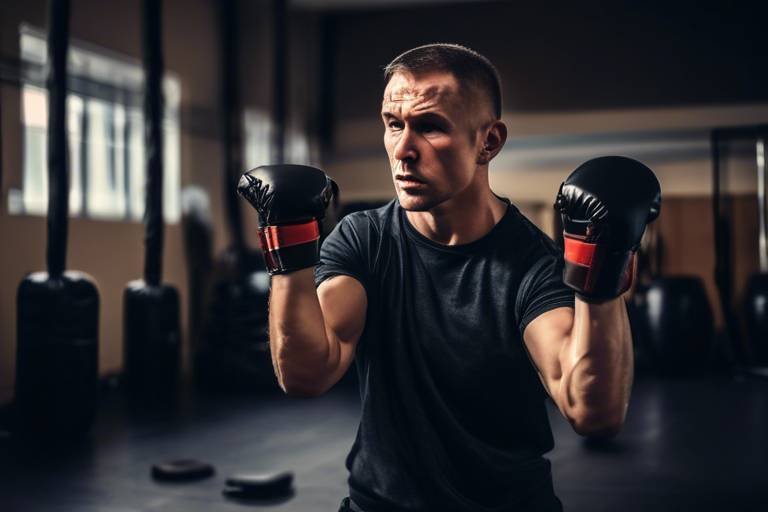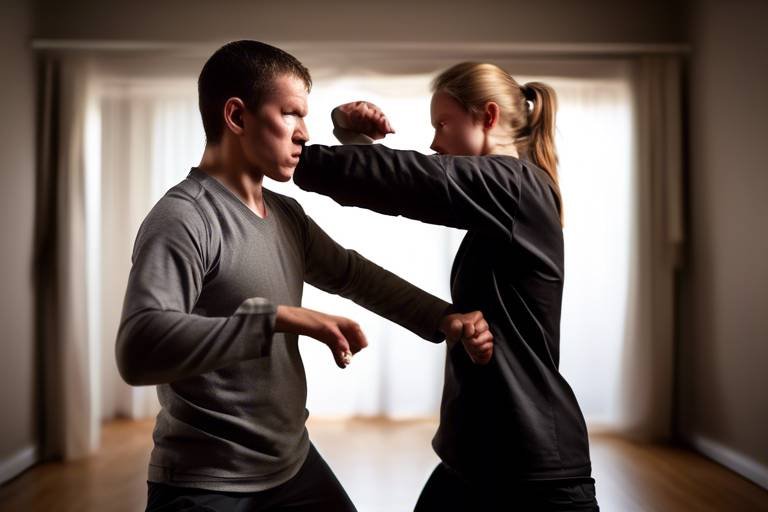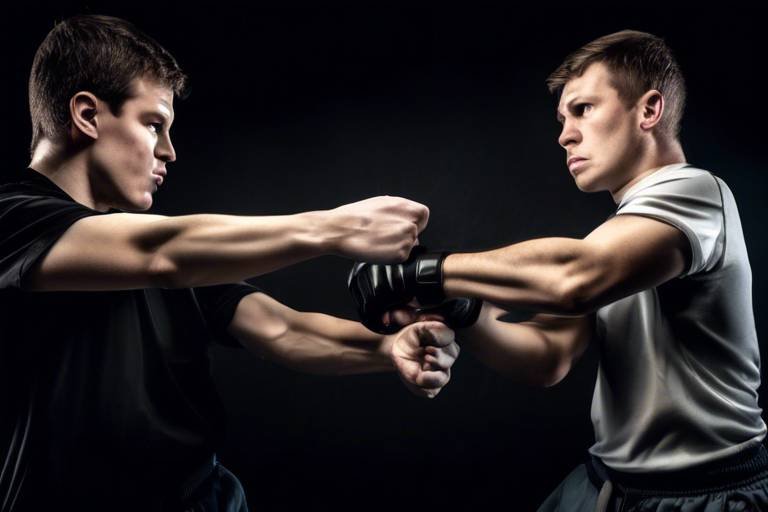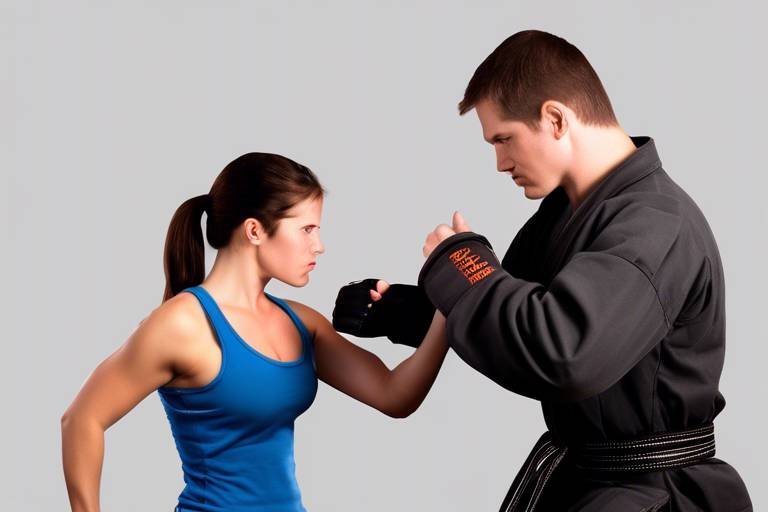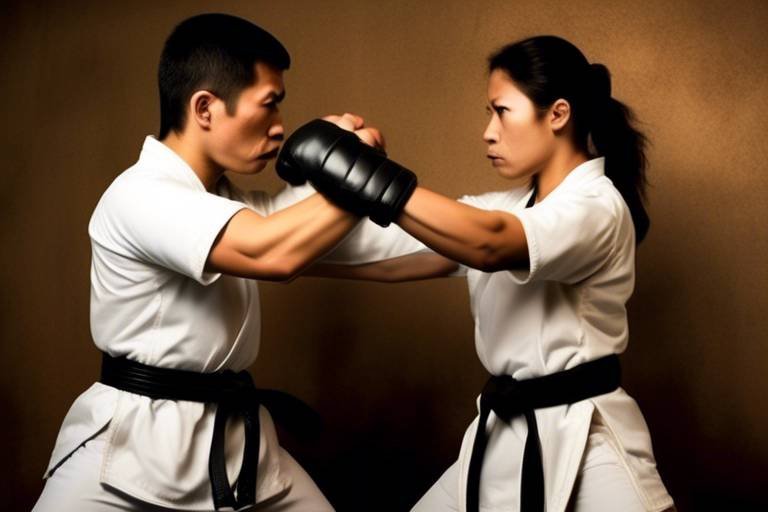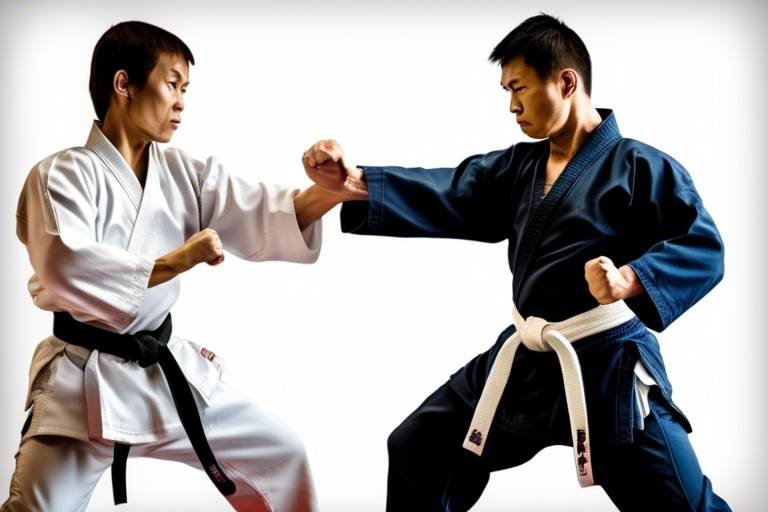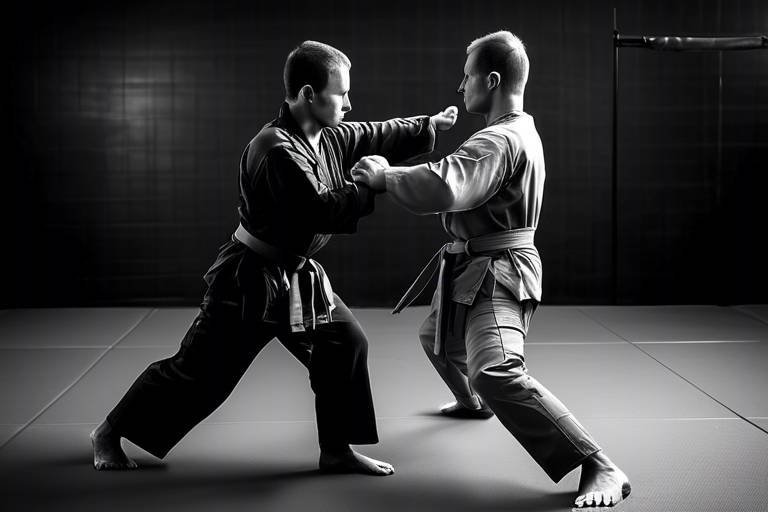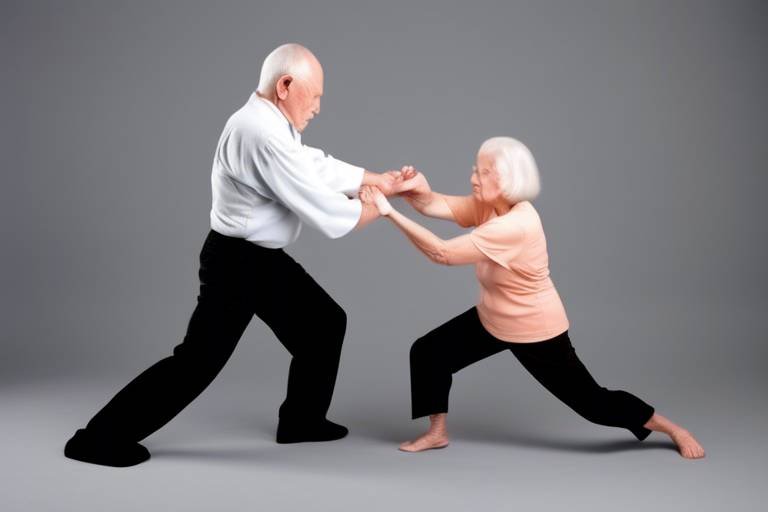How to Make Everyday Routines a Part of Your Self-Defense Training?
In today's world, where unpredictability lurks around every corner, integrating self-defense training into your daily life can be a game-changer. Imagine walking down the street, not just as another pedestrian, but as someone who possesses the skills and awareness to navigate potential threats. This isn’t about living in fear; it’s about empowerment. By incorporating self-defense techniques into your everyday activities, you can enhance your personal safety and boost your confidence without dedicating extra time to formal training sessions. So, how do you weave self-defense into the fabric of your daily routines? Let’s dive into some practical strategies!
First off, it’s crucial to recognize that self-defense is more than just physical confrontations. It’s a holistic approach that includes awareness, prevention, and de-escalation. Think of self-defense as a mental shield—it's about being prepared, not just physically, but also mentally. By understanding its principles, you can feel empowered and ready to tackle everyday situations with a new perspective. This foundational knowledge allows you to approach your surroundings with a critical eye, making you less of a target and more of a resilient individual.
Now, let’s talk about how to seamlessly integrate self-defense techniques into your daily activities. Whether you’re walking to work, commuting, or even exercising, there are countless opportunities to practice your skills. For instance, when you’re out for a walk, you could consciously focus on your posture and how you carry yourself. A confident stance can deter potential threats. Additionally, consider using your commute as a training ground. Instead of zoning out with your headphones, take a moment to observe your surroundings—this simple shift can significantly enhance your situational awareness.
One of the most effective ways to develop your self-defense skills is through mindfulness. By practicing mindfulness, you can stay aware of your surroundings and recognize potential threats before they escalate. Imagine you’re in a crowded area; instead of being lost in thought, you can train yourself to scan the environment. This heightened awareness can be your first line of defense. But how do you cultivate this skill? It starts with small exercises, like dedicating a few moments each day to focus on your immediate environment. Pay attention to the people around you, their body language, and any unusual behaviors.
To further enhance your situational awareness, there are specific techniques you can adopt. Here are a few strategies:
- Scanning Environments: Regularly look around and take mental notes of exits, potential hazards, and people near you.
- Observing Body Language: Learn to read non-verbal cues. Recognizing signs of aggression or discomfort can help you assess risks more effectively.
- Practicing Observation Skills: Engage in exercises that sharpen your attention to detail, such as memory games or even simple activities like recalling what you saw during your walk.
In addition to mental preparedness, physical conditioning plays a vital role in effective self-defense. You don’t need to become a bodybuilder, but incorporating exercises that improve your strength, agility, and endurance can make a significant difference. Think of it as building your personal fortress—each workout fortifies your body, making you more capable in threatening situations. Activities like jogging, martial arts, or even yoga can enhance your physical capabilities while also providing you with a sense of accomplishment.
Developing a self-defense mindset is equally important. This involves cultivating confidence and assertiveness. You want to walk into any situation feeling like you’ve got the tools to handle whatever comes your way. One effective technique is visualization. By mentally rehearsing self-defense scenarios, you can boost your confidence and preparedness. Imagine yourself successfully navigating a confrontation—this mental imagery can translate into real-life effectiveness.
Regular practice is key to building confidence in your abilities. Just like any skill, the more you train, the more comfortable you become. Whether it’s practicing a few moves at home or attending a class once a week, consistent training contributes to a stronger self-defense mindset. Remember, it’s not just about physical skills; it’s about developing a resilient mental attitude that prepares you for unexpected challenges in life.
Engaging with a community can significantly enhance your self-defense training experience. Joining classes, groups, or online forums not only provides structured training opportunities but also offers motivation and support. Surrounding yourself with like-minded individuals can bolster your self-defense journey, creating a network of encouragement and shared learning experiences.
Exploring local self-defense classes can open doors to structured training. Look for reputable instructors and programs that fit your needs. Many communities offer workshops or ongoing classes that cater to various skill levels. Don't hesitate to ask around or check online reviews to find the right fit for you.
Having a network of supportive individuals can make a world of difference. Connect with others who share your interest in self-defense. This community can provide encouragement, share experiences, and even practice together. Remember, you’re not alone on this journey; there are many others eager to learn and grow alongside you.
Q1: Can self-defense training fit into a busy schedule?
A1: Absolutely! Small adjustments to your daily routines can make a big difference. Incorporate awareness exercises while commuting or practice physical conditioning during your workouts.
Q2: Do I need to be physically fit to start self-defense training?
A2: Not at all! Self-defense training can be adapted to various fitness levels. The focus is on building skills and confidence over time.
Q3: How can I stay motivated in my self-defense journey?
A3: Joining a community or finding a training partner can keep you motivated. Share your goals, celebrate milestones, and learn from each other!

Understanding Self-Defense
Self-defense is often misconstrued as strictly a physical confrontation, but it is so much more than that. In essence, self-defense encompasses a range of skills and strategies designed to enhance personal safety and confidence. It’s about being aware of your surroundings, understanding potential threats, and knowing how to respond effectively. Imagine walking down a busy street; your ability to stay alert and recognize unusual behavior can be the difference between safety and danger. This awareness is the cornerstone of self-defense.
At its core, self-defense is about empowerment. It’s not just about learning how to throw a punch or execute a kick; it’s about cultivating a mindset that prepares you for various situations. This involves understanding the principles of prevention, de-escalation, and conflict resolution. For instance, consider the following key principles:
- Awareness: Being conscious of your environment and the people in it.
- Prevention: Taking proactive steps to avoid dangerous situations.
- De-escalation: Using verbal communication to diffuse potential conflicts.
By embracing these principles, you can significantly enhance your ability to react appropriately in threatening situations. It’s about creating a mental framework that allows you to assess risks and make informed decisions quickly. Think of it as building a safety net around your daily life; the more aware you are, the less likely you are to fall into dangerous traps.
Moreover, understanding self-defense also involves recognizing that not every situation requires a physical response. Often, the best defense is to avoid confrontation altogether. This mindset shift can be incredibly liberating, allowing you to navigate through life with a sense of security and confidence. In fact, studies have shown that individuals who practice self-defense techniques report feeling more empowered and capable in their daily lives.
In summary, self-defense is a multifaceted concept that goes beyond physical techniques. It’s about awareness, prevention, and mental readiness. By integrating these elements into your daily life, you not only prepare yourself for potential threats but also cultivate a stronger sense of self. So, the next time you step outside, remember that self-defense starts long before any confrontation; it begins with a keen awareness of your surroundings and a commitment to your personal safety.

Incorporating Self-Defense into Daily Activities
Integrating self-defense techniques into your everyday routines doesn’t have to be a daunting task. In fact, it can be as simple as making a few conscious adjustments to your daily activities. Think about it: you already have a busy life filled with commuting, exercising, and running errands. Why not transform these mundane tasks into opportunities for self-defense training? By weaving self-defense principles into your daily life, you not only enhance your skills but also boost your confidence and awareness without needing extra time in your schedule.
For instance, consider your daily commute. Whether you're walking to the bus stop or navigating a busy street, this is an excellent time to practice situational awareness. Keep your head up, and take a moment to scan your surroundings. Notice the people around you, their body language, and the environment. Are there any potential escape routes if you feel uncomfortable? By doing this, you’re not just passively moving from point A to B; you’re actively engaging in your own safety. Remember, self-defense starts with being aware of your surroundings.
Moreover, when you’re exercising, you can incorporate self-defense moves into your routine. For example, while jogging, practice your footwork by incorporating lateral movements or sudden stops. You can even throw in some defensive stances or shadowboxing routines during your workout. Not only will this enhance your physical conditioning, but it will also engrain self-defense techniques into your muscle memory, making them second nature. It’s like multitasking for your safety—getting fit while preparing yourself for unexpected situations!
Another everyday activity where you can integrate self-defense is during grocery shopping or running errands. As you navigate through crowded aisles, practice your observation skills. Pay attention to how people move and where they are positioned. This can help you develop a keen sense of awareness about potential threats. Additionally, when reaching for items on high shelves, practice your balance and posture. This not only helps you physically but also keeps you grounded and aware of your surroundings.
Lastly, don’t forget to engage in social interactions with a self-defense mindset. Whether you’re chatting with a friend or interacting with a cashier, maintain a confident posture and eye contact. This not only portrays confidence but also helps you build assertiveness, an essential component of self-defense. When you project confidence, you are less likely to be targeted by those with malicious intent.
In summary, incorporating self-defense into your daily activities is all about being intentional. By making small adjustments to your routines, you can significantly enhance your skills and awareness. It’s not about setting aside hours for training; it’s about transforming the moments you already have into opportunities for growth. So next time you step out, remember: every step can be a step towards empowerment!
- Can I really learn self-defense without formal training? Yes, while formal training is beneficial, incorporating self-defense principles into daily activities can significantly enhance your awareness and preparedness.
- How can I stay motivated to practice self-defense daily? Set small, achievable goals and track your progress. Engaging with a community or finding a training buddy can also keep you motivated.
- What if I don’t have time to practice? Look for opportunities in your daily routine to practice awareness and physical conditioning. Even small actions can make a difference.

Mindfulness and Awareness
This article explores how to seamlessly integrate self-defense training into daily routines, enhancing personal safety and confidence in various situations. Discover practical tips and techniques for effective training.
Self-defense is not just about physical confrontations; it encompasses awareness, prevention, and de-escalation. Understanding its principles can help individuals feel empowered and prepared in everyday situations.
Integrating self-defense techniques into daily routines, such as walking, commuting, or exercising, can enhance your skills without requiring extra time. Simple adjustments can make a significant impact on personal safety.
Practicing mindfulness is like tuning a radio to the right frequency; it helps you stay aware of your surroundings and the people in them. Imagine walking down the street, your mind preoccupied with the day's tasks. Suddenly, you realize you're not fully present, and that's when danger can sneak up on you. By developing mindfulness, you cultivate the ability to recognize potential threats before they escalate.
Mindfulness isn't just about meditation; it's about being conscious of your environment. This skill can be crucial in recognizing potential threats and responding effectively to them in real-time. Here are some techniques to enhance your mindfulness:
- Focus on your breath: Take a few moments to breathe deeply, grounding yourself in the present.
- Engage your senses: Notice the sounds, sights, and smells around you. This can help you become more attuned to changes in your environment.
- Practice active listening: Pay attention to conversations and sounds. This not only heightens awareness but also helps you detect unusual behaviors.
By incorporating these practices into your daily life, you can sharpen your situational awareness, making it easier to identify potential dangers. Think of it as a mental workout; the more you practice, the stronger your awareness becomes. You’ll find yourself naturally scanning your environment, observing body language, and picking up on cues that you might have missed before.
Learning specific techniques to heighten your situational awareness can significantly improve your ability to assess risks. For example, when walking in a crowded area, try to maintain a comfortable distance from others while still being aware of your surroundings. This distance gives you room to react if someone approaches too closely.
Another essential technique is to regularly change your routes. By varying your path, you become more observant of your surroundings. This practice not only enhances your awareness but also helps you identify potential escape routes should you ever need them.
Improving your observation skills can make you more attuned to your surroundings. This subheading discusses exercises to enhance focus and attention, crucial for self-defense. Try engaging in activities that require close attention, such as playing memory games or participating in scavenger hunts. These activities help train your brain to notice details, making it easier to spot unusual behavior or potential threats.
Incorporating mindfulness and awareness into your daily routine is not just beneficial for self-defense; it also enhances your overall quality of life. You'll find that being present and aware can reduce stress, improve your relationships, and increase your overall happiness. So, why not start today? Take a moment to breathe, observe, and appreciate your surroundings. Your mind and body will thank you.
Developing a self-defense mindset involves cultivating confidence and assertiveness. This section explores techniques to build mental resilience and prepare you for unexpected challenges.
Visualization can boost confidence and preparedness. Learn how to use mental imagery to rehearse self-defense scenarios and enhance your response in real situations.
Regular practice builds confidence in your abilities. This subheading discusses the importance of consistent training and how it contributes to a stronger self-defense mindset.
Engaging with a community can enhance your self-defense training experience. This section discusses the benefits of joining classes, groups, or online forums for motivation and support.
Exploring local self-defense classes can provide structured training opportunities. This subheading highlights how to find reputable instructors and programs that fit your needs.
Having a network of like-minded individuals can bolster your self-defense journey. This section discusses how to connect with others for encouragement and shared learning experiences.
Q: Can mindfulness really help in self-defense?
A: Absolutely! Mindfulness enhances your awareness of surroundings, allowing you to identify potential threats more effectively.
Q: How often should I practice self-defense techniques?
A: Regular practice is key! Aim for at least a few times a week to build muscle memory and confidence.
Q: Are there any online resources for self-defense training?
A: Yes, many reputable websites and platforms offer online self-defense courses that you can follow at your own pace.

Situational Awareness Techniques
When it comes to self-defense, having a keen sense of your surroundings can be a game-changer. Imagine walking down a busy street, earbuds in, completely absorbed in your playlist. Now, picture this: you’re missing out on crucial cues from your environment that could alert you to potential dangers. Situational awareness isn't just about seeing; it's about observing, interpreting, and reacting to your environment. To sharpen this skill, there are several techniques you can incorporate into your daily life.
First off, let's talk about scanning your environment. This means taking a moment to look around you, not just at your phone or the ground. When you enter a new space—be it a café, a park, or even your office—take a quick mental note of the exits, the people around you, and any potential hazards. This practice can help you develop a mental map of your surroundings, making it easier to react if something feels off.
Another important aspect is observing body language. People communicate a lot through their physical presence. Are they clenching their fists? Is their posture tense? These nonverbal cues can indicate discomfort or aggression. By honing your ability to read body language, you can better gauge whether a situation is escalating. Remember, it’s not just about what people say, but how they say it.
Additionally, you can enhance your situational awareness by practicing mindfulness exercises. These exercises can range from simple breathing techniques to more structured activities like meditation. By grounding yourself in the present moment, you’ll find it easier to notice subtle changes in your environment. For example, try taking a walk without any distractions. Focus on the sounds, sights, and even smells around you. This practice can significantly improve your ability to stay alert.
To wrap it all up, integrating these techniques into your daily routine can drastically improve your situational awareness. Here’s a quick overview of the techniques discussed:
| Technique | Description |
|---|---|
| Scanning | Regularly assess your environment for exits and potential threats. |
| Body Language Observation | Learn to read nonverbal cues to gauge others' intentions. |
| Mindfulness Exercises | Practice being present to enhance your awareness of surroundings. |
By consistently applying these techniques, you’ll not only become more aware but also more confident in your ability to navigate various situations. Remember, self-defense isn't just about physical confrontation; it's about being prepared and aware at all times.
Q: What is situational awareness?
A: Situational awareness is the ability to perceive and understand your surroundings, identifying potential threats and reacting accordingly.
Q: How can I improve my situational awareness?
A: You can improve it through practices like scanning your environment, observing body language, and engaging in mindfulness exercises.
Q: Is situational awareness only important for self-defense?
A: No, situational awareness is beneficial in many areas of life, including driving, workplace safety, and general social interactions.

Practicing Observation Skills
Observation skills are an essential component of self-defense training, acting as your first line of defense against potential threats. Imagine walking down a busy street; while you may be focused on your phone or lost in thought, the ability to notice your surroundings can make all the difference. It’s like being a detective in your own life, where every detail counts. Practicing these skills doesn’t just enhance your awareness; it empowers you to react appropriately when faced with unexpected situations.
One effective way to sharpen your observation skills is through intentional practice. Start by setting aside a few minutes each day to engage in exercises that promote focus and attention. For instance, you can take a walk in your neighborhood and consciously observe the environment around you. Try to notice:
- The color and make of cars parked along the street.
- The types of plants and trees in your vicinity.
- The people you encounter—are they alone or in groups? What are they doing?
By actively engaging with your surroundings, you train your brain to pick up on details that might otherwise go unnoticed. This practice not only helps you become more aware but also enhances your ability to identify potential threats. Think of it as tuning a radio; the clearer your signal, the more you’ll hear.
Another effective method is to practice mindfulness techniques. Mindfulness teaches you to focus on the present moment, making you more attuned to what’s happening around you. For example, when you find yourself in a public place, take a moment to close your eyes, breathe deeply, and then open your eyes to scan the area. Notice the sounds, the movements, and the overall atmosphere. This practice can significantly enhance your situational awareness, allowing you to detect changes in your environment that may indicate a potential threat.
Incorporating observation exercises into your daily life can also be a fun way to improve your skills. Consider playing games that challenge your memory and attention to detail. For example, you might try to remember the layout of a store you frequently visit or the faces of people you pass on the street. This not only makes you more observant but also builds your confidence in your ability to notice and react to your surroundings.
Finally, don’t underestimate the power of reflection. After an outing, take a moment to think about what you observed. Were there any unusual behaviors or situations that stood out? This reflection can help solidify your skills and prepare you for future encounters. Remember, becoming more observant is a journey, and every little step you take enhances your overall self-defense capabilities.
Q: How can I improve my observation skills in everyday situations?
A: Start by practicing mindfulness and engaging in intentional observation exercises. Pay attention to your surroundings and challenge yourself to notice details that you might normally overlook.
Q: Are there specific techniques for enhancing situational awareness?
A: Yes! Techniques such as scanning your environment regularly, observing body language, and reflecting on your experiences can significantly improve your situational awareness.
Q: How often should I practice my observation skills?
A: Incorporate observation exercises into your daily routine. Even a few minutes a day can lead to noticeable improvements over time.

Physical Conditioning for Self-Defense
When it comes to self-defense, having the right mindset is crucial, but let’s not forget about the body! Physical conditioning plays a vital role in ensuring that you can respond effectively in a challenging situation. Think of your body as a finely tuned machine; without the right fuel and maintenance, it can falter when you need it most. So, how can you incorporate physical conditioning into your everyday routine to enhance your self-defense skills?
First off, let’s talk about the importance of strength, agility, and endurance. These three components are essential not only for self-defense but for overall well-being. Strength helps you to effectively push away or restrain an aggressor, agility allows you to maneuver quickly in tight situations, and endurance ensures that you can keep going when the adrenaline is pumping. By integrating specific exercises into your daily life, you can build these attributes without dedicating a ton of extra time.
Consider incorporating activities that naturally enhance these skills. For instance, bodyweight exercises like push-ups, squats, and lunges can be done almost anywhere. You don’t need a gym membership to get stronger! These exercises can be performed during a quick break at work or even while watching TV at home. Additionally, activities like yoga or martial arts not only improve flexibility and strength but also teach you valuable self-defense techniques.
Another excellent way to boost your physical conditioning is through cardiovascular exercises. Whether it’s jogging, cycling, or even taking brisk walks, getting your heart rate up is crucial. Not only does this improve your endurance, but it also helps you manage stress better. Imagine being in a tense situation; if you’re physically fit, your body will be better equipped to handle the stress and make quick decisions. Plus, you’ll feel more confident in your abilities!
To make this even easier, you can create a weekly workout schedule that incorporates different types of exercises. Here’s a simple template to get you started:
| Day | Activity | Duration |
|---|---|---|
| Monday | Strength Training | 30 minutes |
| Tuesday | Cardio (Jogging) | 30 minutes |
| Wednesday | Yoga | 30 minutes |
| Thursday | Strength Training | 30 minutes |
| Friday | Cardio (Cycling) | 30 minutes |
| Saturday | Martial Arts Class | 1 hour |
| Sunday | Rest Day | - |
By following a structured plan like this, you can ensure that you’re not only improving your physical capabilities but also integrating self-defense training into your routine. Remember, consistency is key! It’s better to do a little bit regularly than to push yourself too hard and risk burnout.
In conclusion, physical conditioning is an essential part of self-defense training. It empowers you to react quickly and effectively, boosting both your confidence and your ability to protect yourself. So, why not start today? Your body will thank you, and you’ll feel more prepared for whatever life throws your way!
- What is the best exercise for self-defense?
While there isn't a single best exercise, a combination of strength, agility, and cardiovascular workouts will prepare you best for self-defense situations. - How often should I train for self-defense?
Consistency is key. Aim for at least 3-4 times a week, incorporating both physical conditioning and self-defense techniques. - Do I need to be in great shape to learn self-defense?
No! Self-defense can be learned at any fitness level. Start where you are and gradually improve your physical conditioning.

Creating a Self-Defense Mindset
Creating a self-defense mindset is as essential as learning the physical techniques of self-defense. It's about developing a mental framework that empowers you to react confidently and assertively in challenging situations. Think of it as building a mental fortress; it requires both strong foundations and ongoing maintenance. This mindset not only enhances your ability to protect yourself but also boosts your overall confidence in everyday life.
To cultivate this self-defense mindset, you must first embrace the idea that self-defense is not merely a reaction to an attack but a proactive approach to life. This involves a shift in perception—seeing yourself as capable and resilient rather than vulnerable. You might ask yourself, “How can I prepare for the unexpected?” or “What steps can I take today to feel more secure?” These questions are the seeds of a strong self-defense mindset.
One effective technique for developing this mindset is visualization. Visualization allows you to mentally rehearse various scenarios where you might need to defend yourself. Imagine walking down a street and encountering a potential threat. Instead of succumbing to fear, visualize yourself confidently navigating the situation. Picture your body language, your stance, and your voice. This mental rehearsal not only prepares you for real-life encounters but also conditions your mind to respond effectively when faced with danger.
Another crucial aspect of building a self-defense mindset is building confidence through consistent training. Regular practice of self-defense techniques, whether through classes or solo exercises, reinforces your skills and instills a sense of mastery. As you become more proficient, your confidence grows, making you less likely to panic in stressful situations. Remember, confidence is contagious; the more you believe in your abilities, the more others will too.
To further enhance your self-defense mindset, consider engaging in activities that promote mental resilience. Techniques such as meditation, mindfulness, and even journaling can help you develop a clearer mind and a stronger sense of self. These practices encourage you to focus on the present moment, reducing anxiety and improving your ability to make sound judgments in high-pressure scenarios. You might even find that these activities spill over into other areas of your life, helping you handle daily stressors with greater ease.
In summary, creating a self-defense mindset is a multifaceted process that involves:
- Embracing a proactive approach to personal safety.
- Using visualization to mentally rehearse self-defense scenarios.
- Engaging in regular training to build confidence.
- Practicing mindfulness and resilience techniques.
By prioritizing these elements, you can foster a mindset that not only prepares you for potential threats but also empowers you to navigate life with confidence and poise. Remember, self-defense is as much about mental preparedness as it is about physical ability. So, take the time to invest in your mental fortitude; it's a crucial step in your self-defense journey.
Q: How can I start developing a self-defense mindset?
A: Begin by incorporating visualization techniques into your daily routine. Spend a few minutes each day imagining yourself successfully navigating various self-defense scenarios. Additionally, seek out self-defense classes to build your skills and confidence.
Q: Is self-defense training only for those who feel threatened?
A: Not at all! Self-defense training is beneficial for everyone, as it enhances personal safety awareness and builds confidence, regardless of your current feelings of vulnerability.
Q: Can mental exercises like meditation really help in self-defense?
A: Absolutely! Mental exercises such as meditation and mindfulness can improve your focus, reduce anxiety, and enhance your situational awareness, all of which are crucial for effective self-defense.

Visualization Techniques
Visualization techniques are powerful tools that can significantly enhance your self-defense capabilities. Imagine for a moment that you’re preparing for a big presentation. You wouldn't just walk in unprepared, right? You'd mentally rehearse your speech, visualize your success, and anticipate the questions that might arise. The same principle applies to self-defense. By using mental imagery, you can prepare your mind for potential threats and how to respond effectively.
One of the key aspects of visualization is to create a vivid mental picture of scenarios you might encounter. This could be anything from walking alone at night to finding yourself in a crowded place where you feel uneasy. By visualizing these situations, you train your brain to react instinctively, almost like muscle memory. When it comes time to act, your body will respond more quickly because your mind has already rehearsed the scene.
To effectively use visualization techniques, consider the following steps:
- Find a Quiet Space: Choose a calm environment where you can focus without distractions.
- Close Your Eyes: This helps to eliminate visual distractions and allows you to concentrate on your mental imagery.
- Imagine Realistic Scenarios: Visualize specific situations that could occur in your daily life. For example, picture yourself encountering a potentially threatening individual and how you would respond.
- Engage Your Senses: Make your visualization as vivid as possible by incorporating sounds, smells, and feelings. Imagine the adrenaline rush, the sound of your heartbeat, and the texture of the ground beneath your feet.
- Practice Regularly: Just like physical training, consistent practice of visualization techniques strengthens your mental preparedness.
By incorporating these steps into your daily routine, you can develop a stronger self-defense mindset. Visualization not only prepares you for potential threats but also helps to build confidence in your ability to handle challenging situations. When faced with a real-life scenario, your brain will be equipped with the tools it needs to respond effectively and assertively.
Moreover, visualization can also serve as a stress-relief technique. When you visualize yourself successfully navigating a threatening situation, it can reduce anxiety and enhance your overall sense of control. This mental rehearsal allows you to approach situations with a calm and focused mindset, which is crucial for effective self-defense.
In conclusion, visualization techniques are an invaluable addition to your self-defense training. They empower you to mentally prepare for various scenarios, enhance your confidence, and reduce anxiety. By making visualization a part of your daily routine, you can cultivate a strong self-defense mindset that will serve you well in any situation.

Building Confidence Through Training
Building confidence through training is essential for anyone looking to enhance their self-defense skills. Just as a sculptor chisels away at a block of marble to reveal a masterpiece, consistent training helps you carve out a stronger, more confident version of yourself. Think about it: every time you step onto the mat, into the gym, or even practice at home, you're not just learning techniques; you're also reinforcing a belief in your own abilities. This transformation doesn’t happen overnight, but with dedication and the right mindset, you can cultivate a sense of confidence that permeates every aspect of your life.
One of the most effective ways to build confidence is through repetition. When you practice self-defense techniques repeatedly, your body begins to remember the movements, allowing you to execute them instinctively. This muscle memory is crucial when faced with a real-life situation. Imagine being in a high-pressure scenario where your heart is racing. The last thing you want is to be fumbling through your mind for the right move. Instead, you want those techniques to flow naturally, like second nature.
Moreover, training in a supportive environment can significantly boost your confidence. Joining a class or a training group creates a sense of camaraderie among participants. You’re not just training alone; you're part of a community that shares similar goals. This connection can be incredibly motivating. You can challenge each other, share experiences, and celebrate progress together. Consider how much easier it is to push through tough workouts when you have friends by your side, encouraging you to keep going.
Additionally, setting achievable goals can play a pivotal role in building your confidence. Start with small, realistic objectives and gradually increase their complexity as you improve. For instance, you might aim to master a specific technique before moving on to more advanced skills. Each time you achieve one of these goals, no matter how small, you reinforce your belief in your capabilities. This is akin to climbing a staircase: each step you take brings you closer to the top, where your ultimate confidence awaits.
To illustrate the impact of consistent training on confidence, consider the following table that outlines key benefits of regular practice in self-defense training:
| Benefit | Description |
|---|---|
| Muscle Memory | Repetition helps your body remember movements, making them instinctive. |
| Supportive Environment | Training with others fosters a sense of community and motivation. |
| Goal Achievement | Setting and reaching goals builds confidence and a sense of accomplishment. |
| Stress Relief | Physical activity reduces stress, allowing you to feel more centered and confident. |
In conclusion, building confidence through training is not just about learning how to defend yourself; it's about transforming your mindset and embracing the journey of self-improvement. Every practice session is an opportunity to grow stronger, both physically and mentally. So, lace up those shoes, step onto the mat, and embrace the empowering journey of self-defense training. You might just surprise yourself with how far you can go!

Community and Support Systems
Engaging with a community can significantly enhance your self-defense training experience. Think about it: when you’re surrounded by like-minded individuals who share your goals, it’s not just about learning techniques; it’s about building a supportive environment that fosters growth and confidence. Whether you’re a beginner or a seasoned practitioner, having a network of peers can make all the difference. It’s like having a safety net—one that catches you when you stumble and lifts you up when you succeed.
Participating in self-defense classes or workshops can introduce you to a diverse group of people who are all on a similar journey. These interactions not only provide opportunities for learning but also create friendships and bonds that can last a lifetime. Imagine sharing your triumphs and challenges with others who truly understand what you’re going through. This camaraderie can be incredibly motivating, pushing you to train harder and stay committed to your self-defense goals.
In addition to local classes, the internet has opened up a world of possibilities for connecting with others. Online forums, social media groups, and virtual workshops allow you to engage with a global community. You can share tips, ask questions, and even participate in virtual training sessions. This flexibility means you can find support no matter where you are or what your schedule looks like.
When looking for community support, consider the following options:
- Local Self-Defense Classes: These provide structured environments where you can learn from experienced instructors and meet fellow students.
- Online Forums and Social Media Groups: Join discussions, share experiences, and gain insights from a broader audience.
- Workshops and Seminars: Attend events that focus on specific aspects of self-defense, often led by experts in the field.
Building a supportive network is crucial. Not only does it keep you accountable, but it also offers a platform for sharing knowledge and experiences. When you connect with others, you can exchange valuable insights, discuss techniques, and even practice together. This collaborative approach can lead to a deeper understanding of self-defense concepts and improve your overall skills.
Moreover, having a buddy or a group to train with can make practice sessions more enjoyable. You can challenge each other, celebrate milestones, and even engage in friendly competitions. It’s like having a training partner who pushes you to be your best self. And let’s face it, training alone can sometimes feel monotonous, so having a community to share the journey with can keep the motivation alive.
In summary, the importance of community and support systems in self-defense training cannot be overstated. They provide not only a sense of belonging but also practical benefits that enhance your learning experience. So, whether you find your tribe in a local dojo or an online forum, remember that you’re not alone on this journey. Embrace the connections you make, and let them empower you to reach new heights in your self-defense practice.
1. How can I find local self-defense classes?
You can search online for self-defense classes in your area, check community centers, or ask at local gyms. Many martial arts studios also offer introductory classes.
2. Are online self-defense communities effective?
Absolutely! Online communities provide a platform to share experiences and learn from others, and they can be just as beneficial as in-person interactions.
3. What should I look for in a self-defense class?
Look for classes that emphasize practical techniques, have qualified instructors, and foster a supportive environment. Reading reviews and asking for recommendations can also help.
4. Can I practice self-defense techniques alone?
While practicing with a partner is ideal, there are many techniques you can practice solo. Focus on footwork, strikes, and conditioning exercises to build your skills.

Finding Local Self-Defense Classes
When it comes to enhancing your self-defense skills, finding the right local classes is crucial. Imagine stepping into a space filled with energy and determination, where everyone shares a common goal: to feel empowered and safe. But how do you sift through the myriad of options available? First, start by checking community centers, gyms, or martial arts studios in your area. Many of these places offer introductory classes that allow you to dip your toes into the world of self-defense without a hefty commitment.
Another great resource is social media. Platforms like Facebook often have community groups where local events are posted, including self-defense classes. You can also use websites like Meetup to find groups focused on self-defense training. Don’t underestimate the power of word-of-mouth; ask friends, family, or coworkers if they know of any reputable instructors or classes. Personal recommendations can lead you to hidden gems that you might not find through a simple online search.
Once you’ve gathered a list of potential classes, take a moment to evaluate them. Here are some factors to consider:
- Instructor Credentials: Ensure the instructor has proper qualifications and experience in self-defense or martial arts.
- Class Size: Smaller classes often allow for more personalized attention, which can enhance your learning experience.
- Class Focus: Different classes may emphasize various styles or techniques. Choose one that aligns with your goals, whether it's practical self-defense, fitness, or martial arts.
- Trial Classes: Many studios offer a free or low-cost trial class. Take advantage of this to see if the environment and teaching style suit you.
After you've found a few classes that seem promising, don’t hesitate to visit them. Observing a class can give you insight into the dynamics and culture of the training environment. Are the students engaged? Does the instructor provide constructive feedback? These elements can significantly affect your learning experience.
Lastly, consider the logistics. Make sure the class schedule fits into your routine, and check if the location is convenient for you. The easier it is to attend, the more likely you are to stick with it. Remember, self-defense training is not just about learning techniques; it’s about building a community and fostering relationships that support your journey toward greater confidence and safety.
Q: How long does it take to learn self-defense?
A: The time it takes to learn self-defense varies based on the individual and the style of training. However, consistent practice over a few months can lead to significant improvements.
Q: Do I need to be in shape to start self-defense classes?
A: No, self-defense classes often accommodate all fitness levels. The aim is to build your strength and skills over time.
Q: Are self-defense classes suitable for all ages?
A: Absolutely! Many classes are designed for different age groups, ensuring that everyone can learn valuable skills in a safe environment.

Building a Supportive Network
When it comes to self-defense training, having a supportive network is like having an extra layer of armor. It’s not just about learning techniques; it’s about sharing experiences, gaining insights, and motivating each other to stay committed. Imagine trying to lift weights alone without a spotter—it's tough, right? Similarly, training in isolation can lead to burnout and a lack of progress. So, how do you build this essential network? Let’s dive in!
First off, consider joining local self-defense classes. These classes are not only great for learning practical skills but also for meeting others who share your interests. You can find a variety of classes in your area, ranging from martial arts to personal safety workshops. Many gyms and community centers offer introductory sessions, so you can try out a few before committing. Engaging with instructors and fellow participants can create a sense of camaraderie that enhances your learning experience.
Additionally, online forums and social media groups can serve as fantastic platforms for connecting with like-minded individuals. These virtual spaces allow you to share tips, ask questions, and even organize practice sessions. Imagine being able to connect with someone from across the globe who shares your passion for self-defense! You can exchange knowledge, discuss strategies, and offer encouragement, making your training journey much more enjoyable.
Don’t forget about the power of accountability. Having a buddy system in place can significantly boost your motivation. When you know someone is counting on you to show up for practice or to share progress updates, you're less likely to skip sessions. You could set up regular training dates or even challenge each other to learn new techniques. It’s like having a workout partner who keeps you on your toes!
Lastly, consider attending self-defense workshops or community events focused on personal safety. These gatherings often provide opportunities to meet experts in the field, gain valuable insights, and expand your network. Plus, they can be a lot of fun! Engaging with a community not only enhances your skills but also fosters friendships that can last a lifetime. Remember, every connection you make is a step towards a more empowered and confident self.
In summary, building a supportive network is crucial for anyone serious about self-defense. Whether through local classes, online communities, or workshops, the relationships you cultivate will enhance your training experience and keep you motivated. So, reach out, connect, and watch your self-defense skills flourish!
- How can I find local self-defense classes? You can start by searching online for community centers, gyms, or martial arts studios in your area that offer self-defense classes. Websites like Meetup can also help you find local groups.
- What should I look for in a self-defense instructor? Look for instructors who are certified, have experience, and come highly recommended by others. It’s also important that they create a safe and welcoming environment for learners.
- Can I practice self-defense techniques at home? Absolutely! Many techniques can be practiced solo or with a partner. Just ensure you have enough space and that you’re following safety guidelines.
Frequently Asked Questions
- What is self-defense?
Self-defense isn't just about fighting back; it's a comprehensive approach that includes awareness, prevention, and de-escalation techniques. It's about being prepared and feeling empowered in any situation, whether you're walking alone at night or dealing with a tense encounter.
- How can I incorporate self-defense into my daily routine?
You can weave self-defense techniques into your everyday activities by being mindful of your surroundings and practicing simple movements during your commute or workouts. For instance, while walking, you can practice scanning your environment or even doing some basic stretches that mimic self-defense moves.
- What are some mindfulness techniques for self-defense?
Mindfulness is all about staying present and aware. Techniques like deep breathing, focusing on your senses, and regularly checking in with your surroundings can help you spot potential threats before they escalate. Think of it as tuning into your inner radar!
- Why is physical conditioning important for self-defense?
Physical conditioning enhances your strength, agility, and endurance, which are crucial when facing a threat. Regular exercise not only prepares your body for physical challenges but also boosts your confidence, making you feel more capable in tough situations.
- How can I develop a self-defense mindset?
Building a self-defense mindset involves cultivating confidence and assertiveness. Techniques like visualization—imagining yourself successfully handling various scenarios—can significantly enhance your mental preparedness and resilience.
- Where can I find local self-defense classes?
Finding local self-defense classes is easier than you might think! Check community centers, gyms, or martial arts studios in your area. Online platforms also offer a wealth of resources to help you find reputable instructors and programs that suit your needs.
- How can a supportive community help in my self-defense journey?
Engaging with a community provides motivation, encouragement, and shared learning experiences. Connecting with like-minded individuals—whether in classes or online forums—can enhance your training by offering support and diverse perspectives.

